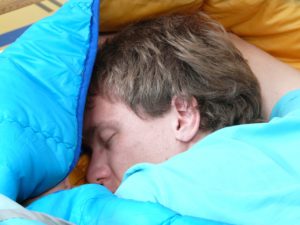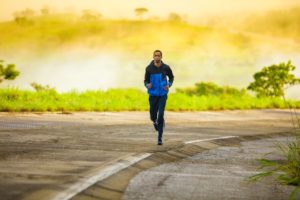There are several effective recovery strategies out there as a means of easing the pain and enhancing the benefits from training. However, many people would have you believe you had to pay for a special tool, book an appointment or buy a special supplement in order to recover effectively. Whilst there is merit to these claims, there are 3 simple strategies that are dismissed/ignored all-to-often, despite how obvious they may be. In this article, I will be discussing 3 ways in which you can enhance your recovery based on research. I cannot stress the importance of focusing on these 3 principles before purchasing any recovery tool.
1. SLEEP
An often overlooked aspect of recovery is the importance of adequate, good quality sleep. It is not uncommon for high level athletes to actually nap during the day to provide the maximal amount of recovery possible.
 During sleep, energy consumption that is normally caused by normal daily movement, is significantly reduced. Within this time, energy is dedicated entirely to homeostasis (returning to normal resting levels) within each bodily system, including hypertrophy of skeletal muscle.
During sleep, energy consumption that is normally caused by normal daily movement, is significantly reduced. Within this time, energy is dedicated entirely to homeostasis (returning to normal resting levels) within each bodily system, including hypertrophy of skeletal muscle.
Studies have found restriction in sleep has found impairments in cognitive (4), metabolic (7, 11) and hormonal functions (1, 5, 8, 11). Whilst many of these studies involved significant sleep deprivations, human sleep deprivation is linked to increases in the release of catabolic hormones such as cortisol (which can cause the breakdown of muscle tissue) (12, 15, 16) and changes in the pattern of testosterone in release (9). Due to this, sleep (or rather a lack of) has been identified to play an important role in the process of muscle recovery (3).
It’s safe to say, sleep may be the factor that you need to be focusing on.
2. DIET
Obviously, this component will heavily depend on your goals, however your diet will significantly improve your recovery above all else. It is essential to understand that diet is used to fuel your training and allow you the capacity to improve. Think about it logically, muscle is made of protein, so you need to consume it to increase in size. Using the same token, the formation of new muscle fibres is a costly process in terms of energy, therefore you need the required caloric intake to fuel this process. Research has highlighted the potential benefits of hyper-caloric refeeding post exercise regarding increased protein synthesis (10, 12).
 Whilst that is an incredible over-complication of nutrition for muscle growth and strength (considering people dedicate their entire lives to this field),you must look to your caloric intake and assess whether it is meeting the demands of your goals.
Whilst that is an incredible over-complication of nutrition for muscle growth and strength (considering people dedicate their entire lives to this field),you must look to your caloric intake and assess whether it is meeting the demands of your goals.
In addition, if you feel as if you are not recovering effectively, how many calories are you consuming? The more complicated aspects (that will be covered here on Strength-Forge) are something to consider further down the line.
3. MOVEMENT
Arguably the most important of the three. People often make the mistake of thinking that rest and recovery involves lying/sitting. However, this is probably the worst thing you could do for your body. This is largely supported by the research as well. In comparison to passive and even short term massage, active recovery has been found to decrease the post exercise blood lactate concentration (2, 6, 14). Whilst this has been questioned as to whether or not it affects subsequent exercise performance, it allows for the relief of post exercise pain and therefore is something important to consider.
In addition, from a theoretical standpoint, returning blood within veins at a low blood pressure is assisted by skeletal muscle acting as a “pump”, in which it literally compresses blood vessels to transport blood back to the heart.  During complete rest (i.e. no movement) this action cannot occur and therefore the removal of metabolic by-products from exercise and transporting vital molecules for recovery will be sub-optimal.
During complete rest (i.e. no movement) this action cannot occur and therefore the removal of metabolic by-products from exercise and transporting vital molecules for recovery will be sub-optimal.
REFERENCES
- Andersen, M. L., Martins, P. J., D’ALMEIDA, V., Bignotto, M., & Tufik, S. (2005). Endocrinological and catecholaminergic alterations during sleep deprivation and recovery in male rats. Journal of sleep research, 14(1), 83-90.
- Bond, V., Adams, R. G., Tearney, R. J., Gresham, K., & Ruff, W. (1991). Effects of active and passive recovery on lactate removal and subsequent isokinetic muscle function. The Journal of sports medicine and physical fitness, 31(3), 357-361.
- Dattilo, M., Antunes, H. K. M., Medeiros, A., Neto, M. M., Souza, H. S., Tufik, S., & De Mello, M. T. (2011). Sleep and muscle recovery: endocrinological and molecular basis for a new and promising hypothesis. Medical hypotheses, 77(2), 220-222.
- Durmer, J. S., & Dinges, D. F. (2005, March). Neurocognitive consequences of sleep deprivation. In Seminars in neurology (Vol. 25, No. 01, pp. 117-129). Copyright© 2005 by Thieme Medical Publishers, Inc., 333 Seventh Avenue, New York, NY 10001, USA..
- Everson, C. A., & Crowley, W. R. (2004). Reductions in circulating anabolic hormones induced by sustained sleep deprivation in rats. American Journal of Physiology-Endocrinology and Metabolism, 286(6), 1060-1070.
- Gupta, S., Goswami, A., Sadhukhan, A. K., & Mathur, D. N. (1996). Comparative study of lactate removal in short term massage of extremities, active recovery and a passive recovery period after supramaximal exercise sessions. International Journal of Sports Medicine, 17(02), 106-110.
- Knutson, K. L., Spiegel, K., Penev, P., & Van Cauter, E. (2007). The metabolic consequences of sleep deprivation. Sleep medicine reviews, 11(3), 163-178.
- Leproult, R., & Van Cauter, E. (2009). Role of sleep and sleep loss in hormonal release and metabolism. In Pediatric Neuroendocrinology (Vol. 17, pp. 11-21). Karger Publishers.
- Luboshitzky, R., Zabari, Z., Shen-Orr, Z., Herer, P., & Lavie, P. (2001). Disruption of the nocturnal testosterone rhythm by sleep fragmentation in normal men. The Journal of Clinical Endocrinology & Metabolism, 86(3), 1134-1139.
- Minor, B. D., Heusinger, D. E., Melanson, E. L., Hamilton, K. L., & Miller, B. F. (2012). Energy balance changes the anabolic effect of postexercise feeding in older individuals. The Journals of Gerontology Series A: Biological Sciences and Medical Sciences, gls080.
- Spiegel, K., Leproult, R., & Van Cauter, E. (1999). Impact of sleep debt on metabolic and endocrine function. The Lancet, 354(9188), 1435-1439.
- Tessari, P., Barazzoni, R., Zanetti, M., Kiwanuka, E., & Tiengo, A. (1996). The role of substrates in the regulation of protein metabolism. Baillière’s clinical endocrinology and metabolism, 10(4), 511-532.
- Treuer, K., Norman, T. R., & Armstrong, S. M. (1996). Overnight human plasma melatonin, cortisol, prolactin, TSH, under conditions of normal sleep, sleep deprivation, and sleep recovery. Journal of pineal research, 20(1), 7-14.
- Watts, P. B., Daggett, M., Gallagher, P., & Wilkins, B. (2000). Metabolic response during sport rock climbing and the effects of active versus passive recovery. International Journal of Sports Medicine, 21(03), 185-190.
- Weibel, L., Follenius, M., Spiegel, K., Ehrhart, J., & Brandenberger, G. (1995). Comparative effect of night and daytime sleep on the 24-hour cortisol secretory profile. Sleep, 18(7), 549-556.
- Weitzman, E. D., Zimmerman, J. C., Czeisler, C. A., & Ronda, J. (1983). Cortisol secretion is inhibited during sleep in normal man. The Journal of clinical endocrinology and metabolism, 56(2), 352.





